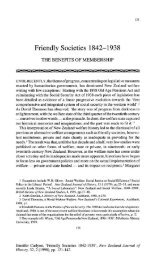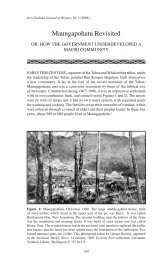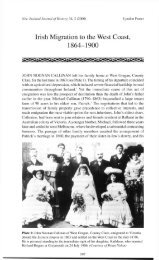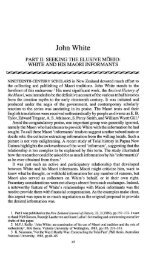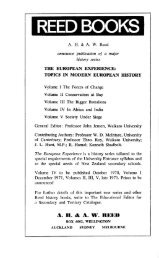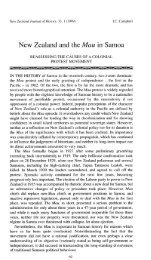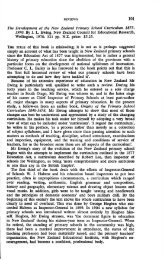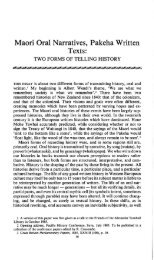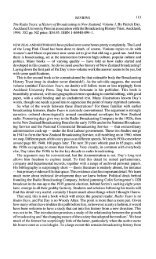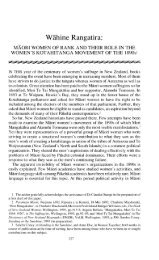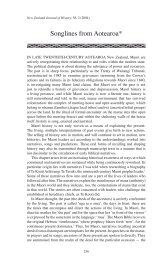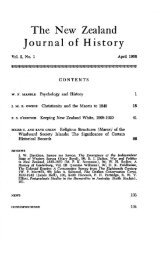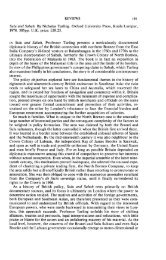Bishop G. A. Selwyn and the Melanesian Mission - New Zealand ...
Bishop G. A. Selwyn and the Melanesian Mission - New Zealand ...
Bishop G. A. Selwyn and the Melanesian Mission - New Zealand ...
Create successful ePaper yourself
Turn your PDF publications into a flip-book with our unique Google optimized e-Paper software.
<strong>Bishop</strong> G. A. <strong>Selwyn</strong> <strong>and</strong> <strong>the</strong><br />
<strong>Melanesian</strong> <strong>Mission</strong><br />
GEORGE AUGUSTUS SELWYN, first <strong>and</strong> only Anglican bishop of <strong>New</strong><br />
Zeal<strong>and</strong>, has always been regarded as a great bishop <strong>and</strong> a great<br />
missionary. The main outline of his <strong>New</strong> Zeal<strong>and</strong> episcopate is well<br />
chronicled; but, as has been pointed out by Harold Miller in a review<br />
of <strong>the</strong> bishop's most recent biography, demythologization <strong>and</strong> a critical<br />
reassessment of his various activities are overdue. 1 In this article<br />
it is proposed to examine three neglected aspects of <strong>Selwyn</strong>'s connection<br />
with <strong>the</strong> <strong>Melanesian</strong> <strong>Mission</strong>: <strong>the</strong> Pacific background to his<br />
foundation of <strong>the</strong> mission, <strong>the</strong> practical feasibility of its distinctive<br />
method of operation, <strong>and</strong> <strong>the</strong> position occupied by <strong>Selwyn</strong> in relation<br />
to subsequent developments within <strong>the</strong> mission.<br />
I<br />
When <strong>Selwyn</strong> was consecrated bishop of <strong>New</strong> Zeal<strong>and</strong> in October<br />
1841 <strong>the</strong> Church of Engl<strong>and</strong> in <strong>the</strong> South Pacific was confined to <strong>the</strong><br />
Australasian colonies. The immediate <strong>and</strong> formal cause of its entry<br />
into <strong>the</strong> Pacific mission field was an error in <strong>Selwyn</strong>'s Letters Patent<br />
which defined <strong>the</strong> nor<strong>the</strong>rn boundary of his newly-created diocese as<br />
34° of latitude north instead of south. 2 <strong>Selwyn</strong>'s ready acceptance of<br />
this document as a commission to evangelize <strong>the</strong> pagan inhabitants<br />
within his see's distended borders found confirmation in a valedictory<br />
letter from Archbishop Howley of Canterbury, who exhorted him to<br />
regard <strong>New</strong> Zeal<strong>and</strong> as 'a fountain diffusing <strong>the</strong> streams of salvation<br />
over <strong>the</strong> isl<strong>and</strong>s <strong>and</strong> coasts of <strong>the</strong> Pacific', 3 <strong>and</strong> it was on Howley's<br />
letter ra<strong>the</strong>r than <strong>the</strong> dubious warrant of a Colonial Office clerk that<br />
1 Review of John H. Evans, Churchman Militant, London <strong>and</strong> Wellington,<br />
1964, in L<strong>and</strong>fall, XX (March 1966), 97-105.<br />
2 The Letters Patent of 14 October 1841 were based on a mistaken definition<br />
of <strong>New</strong> Zeal<strong>and</strong>'s colonial boundaries made in 1840. For a detailed discussion<br />
see Angus Ross, <strong>New</strong> Zeal<strong>and</strong> Aspirations in <strong>the</strong> Pacific in <strong>the</strong> Nineteenth Century,<br />
Oxford, 1964, pp. 13-19.<br />
3 Rev. H. W. Tucker, Memoir of <strong>the</strong> Life <strong>and</strong> Episcopate of George Augustus<br />
<strong>Selwyn</strong>, D.D., London, 1879, I, 85. Cf. John Williams's description of <strong>the</strong><br />
Tahitian mission of <strong>the</strong> London <strong>Mission</strong>ary Society as 'a fountain from whence<br />
<strong>the</strong> streams of salvation are to flow to <strong>the</strong> numerous isl<strong>and</strong>s <strong>and</strong> clusters scattered<br />
over that extensive ocean'. A Narrative of <strong>Mission</strong>ary Enterprises in <strong>the</strong> South<br />
Sea Isl<strong>and</strong>s, London, 1837, p. 5. Howley was undoubtedly acquainted with<br />
Williams's widely-read book.<br />
120
BISHOP G. A. SELWYN AND THE MELANESIAN MISSION 121<br />
<strong>Selwyn</strong> ultimately based his claim to spiritual responsibility for <strong>the</strong><br />
<strong>Melanesian</strong> isl<strong>and</strong>s. As early as 1842, prompted by <strong>Bishop</strong> Broughton<br />
of Sydney, he was toying with <strong>the</strong> idea of a central missionary college<br />
in <strong>New</strong> Zeal<strong>and</strong> with pupils drawn from all parts of <strong>the</strong> South<br />
Pacific, 4 a <strong>the</strong>me to which he returned in <strong>the</strong> Charge to his second<br />
synod in 1847. 5 There is little doubt that <strong>Selwyn</strong> would have<br />
embarked upon this scheme without delay but for external hindrances:<br />
acrimonious wranglings with <strong>the</strong> independent-minded agents of <strong>the</strong><br />
Church <strong>Mission</strong>ary Society over <strong>the</strong> internal organization of <strong>the</strong> Maori<br />
mission, Hone Heke's rebellion, <strong>and</strong> <strong>the</strong> lack of assistant clergy who<br />
shared his fundamental viewpoint <strong>and</strong> whom he felt he could trust. 6<br />
His opportunity finally came in December 1847 when he was able to<br />
visit <strong>the</strong> isl<strong>and</strong>s for <strong>the</strong> first time as acting-chaplain to <strong>the</strong> cruising<br />
warship H.M.S. Dido. This ten weeks' voyage was to be of seminal<br />
importance in <strong>the</strong> evolution of a strategy for his proposed mission.<br />
<strong>Selwyn</strong>'s visit to Samoa was particularly significant. As a High<br />
Churchman he regarded non-episcopal bodies as lying outside <strong>the</strong><br />
Church. Never<strong>the</strong>less, he was a warm admirer of <strong>the</strong> achievements<br />
<strong>and</strong> writings of Samoa's pioneer missionary, John Williams of <strong>the</strong><br />
London <strong>Mission</strong>ary Society, who had been killed by natives of<br />
Eromanga in <strong>the</strong> <strong>New</strong> Hebrides in November 1839. Although he<br />
privately deplored <strong>the</strong> evidences of missionary paternalism, he was<br />
impressed by <strong>the</strong> expansive energy of Polynesian Christianity <strong>and</strong> <strong>the</strong><br />
sending of evangelists to <strong>the</strong> Loyalty Isl<strong>and</strong>s <strong>and</strong> sou<strong>the</strong>rn <strong>New</strong><br />
Hebrides: 'we shall be indeed disgraced, if <strong>the</strong> older <strong>Mission</strong> of <strong>New</strong><br />
Zeal<strong>and</strong> cannot do as much for Melanesia, as its younger brethren<br />
in Samoa <strong>and</strong> Barotonga.' 7 This view was reinforced by his meeting<br />
with John Geddie <strong>and</strong> Isaac Archibald, missionaries from <strong>the</strong> Presbyterian<br />
Church of Nova Scotia, who were waiting in Samoa for a<br />
passage to <strong>the</strong>ir projected new mission field in <strong>the</strong> <strong>New</strong> Hebrides:<br />
'This was a striking lesson for our <strong>New</strong> Zeal<strong>and</strong> Church; for I believe<br />
this was <strong>the</strong> first instance of any Colonial Body sending out its own<br />
<strong>Mission</strong> to <strong>the</strong> hea<strong>the</strong>n, without assistance from <strong>the</strong> mo<strong>the</strong>r country.' 3<br />
From Samoa <strong>and</strong> Tonga <strong>the</strong> Dido sailed westward into Melanesia,<br />
to <strong>the</strong> <strong>New</strong> Hebrides <strong>and</strong> <strong>New</strong> Caledonia. In this part of <strong>the</strong> Pacific<br />
European contact was still in its initial phase. From <strong>the</strong> 1830s whalers<br />
<strong>and</strong> traders for isl<strong>and</strong> produce had called regularly at particular bays<br />
<strong>and</strong> anchorages as far north as <strong>New</strong> Irel<strong>and</strong> <strong>and</strong> <strong>the</strong> Admiralty group,<br />
but it was not until 1841 when s<strong>and</strong>alwood was discovered in quantity<br />
on <strong>the</strong> Isle of Pines, <strong>and</strong> later on adjacent isl<strong>and</strong>s, that trading vessels<br />
* Tucker, I, 129.<br />
5 G. A. <strong>Selwyn</strong>, A Charge delivered to <strong>the</strong> Clergy of <strong>the</strong> Diocese of Nero<br />
Zeal<strong>and</strong> . . . on September 23, 1847, 2nd ed., London, 1849, pp. 19-20.<br />
6 The untimely death in January 1843 of his chaplain, <strong>the</strong> Reverend Thomas<br />
Whytehead, was certainly a factor in <strong>the</strong> delay.<br />
7 G. A. <strong>Selwyn</strong>, Letters on <strong>the</strong> <strong>Melanesian</strong> <strong>Mission</strong> in 1853, London, 1855,<br />
p. 33.<br />
8 ibid., p. 26.
122 DAVID HILLIARD<br />
flocked to <strong>the</strong> area in large numbers. 9 The search for s<strong>and</strong>alwood was<br />
a competitive <strong>and</strong> occasionally bloody enterprise, though it scarcely<br />
deserves its subsequent missionary-fostered reputation for unmitigated<br />
brutality <strong>and</strong> fraud; nor, in <strong>the</strong> light of Dorothy Shineberg's recent<br />
researches, can it be assumed as formerly that <strong>the</strong> <strong>Melanesian</strong>s were<br />
merely passive onlookers to <strong>the</strong>ir own exploitation. In fact, it was no<br />
one-way traffic. The aims of <strong>the</strong> two parties were more similar than<br />
is often realized, for each had goods which <strong>the</strong> o<strong>the</strong>r was eager to<br />
obtain. The coastal peoples were already familiar with <strong>the</strong> concept<br />
of exchange, <strong>and</strong> throughout <strong>the</strong> early period of <strong>the</strong> trade <strong>the</strong>y showed<br />
<strong>the</strong>mselves fully capable of using it for <strong>the</strong>ir own profit <strong>and</strong> advantage.<br />
By <strong>the</strong> time of <strong>Selwyn</strong>'s visit <strong>the</strong> coastal inhabitants of sou<strong>the</strong>rn<br />
Melanesia were becoming accustomed to sustained European contact,<br />
's<strong>and</strong>alwood English' was widely understood, <strong>and</strong> <strong>the</strong>re was a<br />
growing dem<strong>and</strong> for steel tools <strong>and</strong> o<strong>the</strong>r favourite articles of European<br />
manufacture.<br />
At <strong>the</strong> Isle of Pines <strong>Selwyn</strong> met <strong>the</strong> veteran s<strong>and</strong>alwooder, James<br />
Paddon, who in 1844 had established <strong>the</strong> first permanent trading<br />
station in <strong>the</strong> south-west Pacific in Anelgauhat harbour on Aneityum.<br />
Despite <strong>the</strong> forbidding reputation of <strong>the</strong> <strong>Melanesian</strong>s for savagery,<br />
Paddon seemed safe enough — a state of affairs due, so he told<br />
<strong>Selwyn</strong>, to his humane treatment of <strong>the</strong> isl<strong>and</strong>ers <strong>and</strong> generous payment<br />
in trade goods for services rendered. 'I confess', <strong>Selwyn</strong> noted<br />
at <strong>the</strong> time, 'that I was not ashamed to ponder well upon this wisdom<br />
of <strong>the</strong> children of this world, <strong>and</strong> to draw from it many hints for<br />
<strong>the</strong> guidance of our future operations.' 10<br />
Ano<strong>the</strong>r influence on <strong>Selwyn</strong>, often underestimated, is <strong>the</strong> vision<br />
of his friend <strong>and</strong> contemporary, Sir George Grey, of <strong>New</strong> Zeal<strong>and</strong><br />
as <strong>the</strong> natural centre of British <strong>and</strong> Christian civilization in <strong>the</strong> South<br />
Pacific. 11 During 1848 Grey was attempting — unsuccessfully as it<br />
turned out — to persuade <strong>the</strong> Colonial Office of <strong>the</strong> immense economic,<br />
strategic <strong>and</strong> political advantages which would follow from <strong>the</strong><br />
immediate annexation of Tonga <strong>and</strong> Fiji, <strong>and</strong> he was <strong>the</strong>refore prepared<br />
to encourage any project which would assist his design. <strong>Selwyn</strong><br />
himself was no aggressive imperialist. He had no doubt that English<br />
Christianity <strong>and</strong> English civilization marched forward toge<strong>the</strong>r, with<br />
<strong>the</strong> rule of law as an essential concomitant of true religion, but this<br />
did not necessarily imply <strong>the</strong> direct extension of British rule. Ra<strong>the</strong>r<br />
he saw Britain's rôie in <strong>the</strong> South Pacific as one of stewardship. A<br />
great <strong>and</strong> wealthy power, whose subjects predominated among<br />
Europeans in <strong>the</strong> isl<strong>and</strong>s, had <strong>the</strong> responsibility under God to prevent<br />
injustice <strong>and</strong> violence between <strong>the</strong> races, especially on <strong>the</strong> <strong>Melanesian</strong><br />
9 On <strong>the</strong> <strong>New</strong> Hebrides s<strong>and</strong>alwood trade see Dorothy Shineberg, They Came<br />
for S<strong>and</strong>alwood: A Study of <strong>the</strong> S<strong>and</strong>alwood Trade in <strong>the</strong> South-west Pacific<br />
1830-1865, Melbourne, 1967. In <strong>the</strong> decade 1841-51 at least 150 s<strong>and</strong>alwood<br />
voyages were made to this region.<br />
10 <strong>Selwyn</strong>, Letters, p. 42.<br />
11 Ross, pp. 41-51; T. Ru<strong>the</strong>rford, Sir George Grey: A Study in Colonial<br />
Government, London, 1961, pp. 268-72.
BISHOP G. A. SELWYN AND THE MELANESIAN MISSION 123<br />
frontier. This police work should be carried out by a patrolling warship,<br />
under 'a really enlightened naval officer', which would radiate<br />
'moral influence' <strong>and</strong> 'good example' in place of <strong>the</strong> customary technique<br />
of retaliatory bombardment. 12 As a Christian bishop he would<br />
willingly co-operate with <strong>the</strong> captain in this work of pacification: 'I<br />
would . . . serve under him as Chaplain on board <strong>the</strong> Undine [his<br />
episcopal schooner] acting as Tender to <strong>the</strong> Man of War, for <strong>the</strong><br />
purpose of establishing peaceful <strong>and</strong> Christian relations with all <strong>the</strong><br />
Isl<strong>and</strong>ers who are now implicated in past massacres, <strong>and</strong> of assuring<br />
<strong>the</strong>m of a general amnesty for <strong>the</strong> past, upon <strong>the</strong> condition of peaceful<br />
<strong>and</strong> friendly behaviour for <strong>the</strong> future.' 13 In this way, so <strong>Selwyn</strong><br />
reasoned, British naval justice would serve as a preparatio evangelica<br />
for <strong>the</strong> pagan isl<strong>and</strong>s of <strong>the</strong> south-west Pacific.<br />
It was against <strong>the</strong> background of Grey's imperialist ambitions <strong>and</strong><br />
<strong>the</strong> experiences accumulated during his isl<strong>and</strong> voyage that <strong>Selwyn</strong><br />
drew up plans for a mission to <strong>the</strong> <strong>Melanesian</strong> portion of his diocese.<br />
Unfortunately for his gr<strong>and</strong> design, he was not <strong>the</strong> first missionary<br />
on <strong>the</strong> scene. The martyrdom of John Williams had stimulated <strong>the</strong><br />
L.M.S. to continue <strong>the</strong> work he had begun, <strong>and</strong> during <strong>the</strong> 1840s<br />
Samoan <strong>and</strong> <strong>the</strong> Rarotongan teachers were sent to a number of places<br />
in <strong>the</strong> <strong>New</strong> Hebrides, <strong>New</strong> Caledonia <strong>and</strong> <strong>the</strong> Loyalty Isl<strong>and</strong>s. The<br />
Marist Fa<strong>the</strong>rs, after abortive attempts to found missions at Balade<br />
<strong>and</strong> Puebo on <strong>New</strong> Caledonia <strong>and</strong> on San Cristobal in <strong>the</strong> Solomons,<br />
were in <strong>the</strong> process of failing in ano<strong>the</strong>r on isl<strong>and</strong>s off <strong>the</strong> eastern<br />
coast of <strong>New</strong> Guinea. Presbyterians from Nova Scotia were on <strong>the</strong>ir<br />
way to <strong>the</strong> <strong>New</strong> Hebrides where, in July 1848, <strong>the</strong>y settled on Aneityum.<br />
These Christian efforts had been small in scale, hesitant in<br />
execution <strong>and</strong>, in contrast to <strong>the</strong> mass conversions which had occurred<br />
elsewhere in <strong>the</strong> Pacific, markedly unsuccessful, but <strong>the</strong>y could not<br />
be ignored. It was <strong>Selwyn</strong>'s error to underestimate <strong>the</strong> attachment of<br />
o<strong>the</strong>r missionary bodies to <strong>the</strong> vision of a Melanesia christianized in<br />
<strong>the</strong>ir own image.<br />
Behind <strong>Selwyn</strong>'s plan for <strong>the</strong> mission lay two fundamental assumptions:<br />
first, that native converts should be spared <strong>the</strong> unedifying<br />
spectacle of competing Christian creeds; second, that Nature had<br />
'marked out for each missionary body its field of duty'. 14 For himself<br />
he had no doubt that Providence was calling <strong>the</strong> Church of Engl<strong>and</strong><br />
through his Letters Patent <strong>and</strong> Howley's commission to take a lead in<br />
<strong>the</strong> evangelization of <strong>the</strong> whole of Melanesia <strong>and</strong> 'carry <strong>the</strong> Gospel<br />
into every isl<strong>and</strong> which has not received it'. 15 He would respect <strong>the</strong><br />
12 See Tucker, I, 310-1, 312-4; Extracts from. <strong>New</strong> Zeal<strong>and</strong> Letters during <strong>the</strong><br />
years 1851-2, Eton, 1853, pp. 15-6; Letters, p. 44; <strong>Selwyn</strong> to W. E. Gladstone.<br />
31 October 1848 <strong>and</strong> 17 November 1850, 'G. A. <strong>Selwyn</strong>, Letters to Gladstone<br />
1828-1860', microfilm, Alex<strong>and</strong>er Turnbull Library, Wellington. For a general<br />
discussion of this topic, see W. N. Gunson, '<strong>Mission</strong>ary Interest in British Expansion<br />
in <strong>the</strong> South Pacific in <strong>the</strong> Nineteenth Century', The Journal of Religious<br />
History, III, 4 (December 1965), 296-313.<br />
13 <strong>Selwyn</strong> to Gladstone, 31 October 1848, he. cit.<br />
i* Tucker, I, 255.<br />
15 ibid., I, 287, 290.
124 DAVID HILLIARD<br />
achievements <strong>and</strong> integrity of o<strong>the</strong>r missions, but <strong>the</strong>irs was to be<br />
<strong>the</strong> lesser portion. The problem was to persuade <strong>the</strong> L.M.S. in particular<br />
to see Melanesia in this light. Collision between <strong>the</strong> two<br />
occurred over <strong>the</strong> <strong>New</strong> Caledonia group, <strong>the</strong> nearest of <strong>the</strong> <strong>Melanesian</strong><br />
isl<strong>and</strong>s to <strong>New</strong> Zeal<strong>and</strong>, which <strong>Selwyn</strong> had marked out for his<br />
'own proper field of missionary duty' even before his visit <strong>the</strong>re. 16<br />
In response to his suggestion, toge<strong>the</strong>r with an assurance that he<br />
would leave <strong>the</strong> <strong>New</strong> Hebrides to <strong>the</strong> L.M.S. or its allies, <strong>the</strong> Samoa<br />
missionaries of <strong>the</strong> L.M.S. consented in June 1848 to <strong>the</strong> transfer of<br />
<strong>the</strong>ir Polynesian teachers in <strong>the</strong> Loyalty Isl<strong>and</strong>s to an Anglican mission<br />
directed by <strong>Selwyn</strong>, which <strong>the</strong>y assumed, <strong>and</strong> later insisted, would be<br />
under <strong>the</strong> C.M.S. This condition, unacceptable to <strong>Selwyn</strong>, was to be<br />
<strong>the</strong> source of all subsequent friction <strong>and</strong> ill-feeling. 17<br />
As <strong>Selwyn</strong> saw it in 1848, Melanesia was still a virgin mission field,<br />
though one which offered little likelihood of quick success. At every<br />
place where Christian teachers had been stationed <strong>the</strong> native peoples<br />
were indifferent to <strong>the</strong> new religion; at best its agents were barely<br />
tolerated, at worst <strong>the</strong>y had been driven off or killed. 18 There were<br />
also physical obstacles to missionary effort. The climate of <strong>the</strong> region<br />
was hot <strong>and</strong> malarial, rendering it unsuitable for prolonged white<br />
residence. There was <strong>the</strong> problem of <strong>the</strong> large number of isl<strong>and</strong>s <strong>and</strong><br />
<strong>the</strong> multiplicity of mutually unintelligible languages. All this, toge<strong>the</strong>r<br />
with <strong>the</strong> impossibility of obtaining a succession of acceptably qualified<br />
English missionaries, seemed to dem<strong>and</strong> a totally new strategy:<br />
ab<strong>and</strong>onment of <strong>the</strong> practice followed elsewhere in <strong>the</strong> Pacific of<br />
aiming at a permanent European station on each major isl<strong>and</strong> in<br />
favour of indigenuous teachers who would christianize <strong>Melanesian</strong><br />
society from within.<br />
<strong>Selwyn</strong> planned to work his 'Nor<strong>the</strong>rn <strong>Mission</strong>' as an extension of<br />
<strong>the</strong> centralized collegiate system which he had inaugurated in 1843<br />
with <strong>the</strong> foundation of St. John's College, moved from Waimate to<br />
Auckl<strong>and</strong> in 1844. This was a large self-supporting establishment,<br />
comprising bishop's residence, a boarding school for European <strong>and</strong><br />
Maori youths <strong>and</strong> a <strong>the</strong>ological college. <strong>Selwyn</strong> hoped that from this<br />
'central reservoir' true religion <strong>and</strong> <strong>the</strong> arts <strong>and</strong> learning of Christian<br />
civilization would radiate outwards throughout <strong>New</strong> Zeal<strong>and</strong> <strong>and</strong><br />
beyond. 19 From his Auckl<strong>and</strong> headquarters he proposed to cruise for<br />
16 The Isle of Pines, to <strong>the</strong> south of <strong>New</strong> Caledonia, was <strong>the</strong> first point 'upon<br />
which <strong>the</strong> missionary energies of <strong>the</strong> <strong>New</strong> Zeal<strong>and</strong> Church ought to be bestowed'.<br />
ibid., I, 276.<br />
17 Most of <strong>the</strong> relevant correspondence between <strong>Selwyn</strong> <strong>and</strong> <strong>the</strong> L.M.S. is<br />
in G. A. <strong>Selwyn</strong> Papers, Folder 1, Auckl<strong>and</strong> Institute <strong>and</strong> Museum Library, MS<br />
273. In <strong>the</strong> L.M.S. records see, generally, <strong>the</strong> Samoan <strong>and</strong> Loyalty Isl<strong>and</strong>s<br />
correspondence 1848-59, South Sea Letters, London <strong>Mission</strong>ary Society Archives,<br />
Westminster (hereinafter SSL). A letter from <strong>Selwyn</strong> to <strong>the</strong> Reverend George<br />
Turner of <strong>the</strong> L.M.S., 12 August 1853, is in The Sou<strong>the</strong>rn Cross Log, Sydney,<br />
January 1906, pp. 7-9.<br />
is The L.M.S. withdrew its teachers from Eromanga (1841), Tana (1843),<br />
Aniwa (1844) <strong>and</strong> <strong>New</strong> Caledonia (1845). Teachers were massacred at <strong>the</strong> Isle<br />
of Pines (1842) <strong>and</strong> Futuna (1843).<br />
On St. John's College see Evans, pp. 99-119.
BISHOP G. A. SELWYN AND THE MELANESIAN MISSION 125<br />
some months each year among <strong>the</strong> various isl<strong>and</strong> groups, opening up<br />
friendly relations with as many people as possible. These were to be<br />
persuaded to entrust to him some of <strong>the</strong>ir most promising young men<br />
who would be taken for <strong>the</strong> summer to St. John's <strong>and</strong> <strong>the</strong>re taught<br />
<strong>the</strong> English language, 'all social <strong>and</strong> civilized habits' <strong>and</strong> <strong>the</strong> basic<br />
doctrines of Christianity. At <strong>the</strong> onset of winter, when <strong>the</strong> <strong>New</strong> Zeal<strong>and</strong><br />
climate became cold <strong>and</strong> wet, <strong>the</strong> <strong>Melanesian</strong> scholars would<br />
be returned to <strong>the</strong>ir own villages where, it was hoped, <strong>the</strong>y would<br />
begin to disseminate knowledge of <strong>the</strong> new religion among <strong>the</strong>ir kinsfolk<br />
<strong>and</strong> friends. If <strong>the</strong>y proved to be intelligent <strong>and</strong> likely to benefit<br />
from fur<strong>the</strong>r instruction, <strong>the</strong>y would be taken again in <strong>the</strong> following<br />
year; if not, o<strong>the</strong>rs would be obtained in <strong>the</strong>ir place. For each scholar<br />
<strong>the</strong> process would be repeated until he was baptized <strong>and</strong> sufficiently<br />
instructed to return permanently to his home to convert his own<br />
people. The supervision, collection <strong>and</strong> return of <strong>the</strong> <strong>Melanesian</strong><br />
scholars would be supervised by <strong>the</strong> bishop himself on his 'floating<br />
<strong>Mission</strong> House', while a small b<strong>and</strong> of carefully chosen assistants<br />
would undertake <strong>the</strong> educational work at <strong>the</strong> central school. 20<br />
<strong>Selwyn</strong>'s plans for <strong>the</strong> later stages of <strong>the</strong> mission are shadowy <strong>and</strong><br />
nowhere spelt out in detail, but he appears to have envisaged <strong>the</strong><br />
fairly rapid creation of an English-speaking <strong>Melanesian</strong> Christian<br />
leadership <strong>and</strong> <strong>the</strong> emergence of a self-governing <strong>Melanesian</strong> church.<br />
The emphasis was on ecclesiastical ra<strong>the</strong>r than doctrinal independence,<br />
for he assumed that this <strong>Melanesian</strong> church would retain <strong>the</strong><br />
episcopal system of government <strong>and</strong> sufficient of <strong>the</strong> Anglican liturgy<br />
<strong>and</strong> formularies to remain in communion with <strong>the</strong> Church of Engl<strong>and</strong><br />
in <strong>New</strong> Zeal<strong>and</strong>. 21<br />
In 1849 <strong>Selwyn</strong> made his first missionary voyage, one of 3,000 miles<br />
on <strong>the</strong> 21-ton schooner Undine, during which he visited <strong>the</strong> sou<strong>the</strong>rn<br />
<strong>New</strong> Hebrides, <strong>New</strong> Caledonia <strong>and</strong> <strong>the</strong> Loyalties under <strong>the</strong> protection<br />
of Captain Erskine of H.M.S. Havannah, <strong>and</strong> returned to Auckl<strong>and</strong><br />
with five youths from <strong>New</strong> Caledonia, Lifu <strong>and</strong> Mare. The two<br />
months' voyage was significant in that <strong>the</strong> Undine was small <strong>and</strong><br />
unarmed; it was a trail-blazer only in its religious aspect, for everywhere<br />
he went <strong>Selwyn</strong> found that <strong>the</strong> s<strong>and</strong>alwooders had preceded<br />
him. Under <strong>the</strong>se circumstances he could only lament <strong>the</strong> entrenched<br />
position, superior numbers <strong>and</strong> resources of <strong>the</strong>se 'emissaries of <strong>the</strong><br />
world' as a st<strong>and</strong>ing reproach to tardy Christians. 22 Never<strong>the</strong>less,<br />
despite its late beginnings <strong>and</strong> small scale, <strong>the</strong> prospects for <strong>the</strong> new<br />
mission seemed promising enough. The Royal Navy granted its protection<br />
again in 1850 when <strong>Selwyn</strong> returned his first scholars to <strong>the</strong>ir<br />
20 <strong>Selwyn</strong>'s plans for <strong>the</strong> <strong>Melanesian</strong> <strong>Mission</strong> are expounded in his letters to<br />
E. Coleridge, 12 August <strong>and</strong> 21 December 1849, published as Two Letters irom<br />
<strong>Bishop</strong> <strong>Selwyn</strong>, Eton, 1850; also in Tucker, I, 286-94, 317-9.<br />
21 For hints see Tucker. I, 287, 292; [Anon.], The Isl<strong>and</strong> <strong>Mission</strong>, London,<br />
1869, p. 19; E. S. Armstrong, The History of <strong>the</strong> <strong>Melanesian</strong> <strong>Mission</strong>, London,<br />
1900, p. 10.<br />
22 Tucker, I, 288, 303.
126 DAVID IIILLIAKD<br />
homes under <strong>the</strong> watchful eye of H.M.S. Fly. The mission's sphere<br />
of operations steadily exp<strong>and</strong>ed. In 1851 <strong>Selwyn</strong> sailed fur<strong>the</strong>r north,<br />
to Malekula on <strong>the</strong> Border Maid in company with <strong>Bishop</strong> Tyrrell of<br />
<strong>New</strong>castle, <strong>and</strong> in <strong>the</strong> following year he reached <strong>the</strong> Banks, Santa<br />
Cruz <strong>and</strong> Solomon groups. On this voyage six young converts were<br />
baptized in <strong>the</strong>ir own villages. 23<br />
In <strong>the</strong>se nor<strong>the</strong>rn isl<strong>and</strong>s, still rarely visited by Europeans, <strong>the</strong><br />
initial contact was a delicate process for which <strong>Selwyn</strong> evolved his<br />
own techniques. Despite <strong>the</strong> lack of a common language it was usually<br />
possible to gain <strong>the</strong> confidence of <strong>the</strong> isl<strong>and</strong>ers by means of 'stray<br />
words', gesticulations, exchange of names, presents, <strong>and</strong> <strong>the</strong> display<br />
of mission scholars from o<strong>the</strong>r isl<strong>and</strong>s. On <strong>the</strong> universal missionary<br />
assumption that all unexpected attacks by <strong>the</strong> isl<strong>and</strong>ers were essentially<br />
acts of retaliation for European misdeeds, he proceeded with<br />
caution, anxious to avoid misunderst<strong>and</strong>ing or offence. For himself<br />
he made it a rule to go ashore unarmed, to keep <strong>the</strong> mission vessel<br />
'in a place of safety', always to obtain <strong>the</strong> consent of parents or kin<br />
before taking scholars, <strong>and</strong> never to 'go anywhere or do anything out<br />
of mere curiosity'. 24 His interpretation of <strong>Melanesian</strong> motives for<br />
violence may be questioned, but as a practical policy it was justified<br />
by its results. Only once, at Malekula in August 1851, was he in real<br />
danger of attack by hostile isl<strong>and</strong>ers. 25<br />
In <strong>the</strong> meantime, <strong>Selwyn</strong>'s mission faced a new threat in <strong>the</strong> form<br />
of French Marist priests who, having withdrawn to Aneityum after<br />
<strong>the</strong>ir earlier unsuccessful bid to enter <strong>New</strong> Caledonia, commenced a<br />
mission on <strong>the</strong> Isle of Pines in 1848 <strong>and</strong> returned to Balade in 1851.<br />
This resurgence of Roman Catholic activity introduced a note of<br />
national as well as religious rivalry. On both counts <strong>Selwyn</strong> was<br />
equally opposed to <strong>the</strong> priests. He admired <strong>the</strong>ir spirit of self-sacrifice,<br />
but he resented <strong>the</strong>ir intrusion into what he regarded as his own<br />
field <strong>and</strong> distrusted <strong>the</strong>ir political motives. Accordingly he was pleased<br />
to observe that <strong>the</strong>y made scanty progress, a fact he was inclined to<br />
attribute ei<strong>the</strong>r to <strong>the</strong> unattractiveness of Romanist error or to <strong>the</strong><br />
French missionaries' deficiency in 'natural tact' <strong>and</strong> <strong>the</strong>ir consequent<br />
inability to secure <strong>the</strong> confidence of <strong>the</strong> isl<strong>and</strong>ers. 'I believe,' he is<br />
reported to have said, 'as regards mission-work in this field, that Lord<br />
Nelson's saying will hold strictly true — "That one Englishman is<br />
23 The only extant account of <strong>the</strong> 1850 voyage appears to be by William Nihill,<br />
one of <strong>Selwyn</strong>'s assistants. 'Journal of a voyage to <strong>the</strong> <strong>New</strong> Hebrides, <strong>New</strong><br />
Caledonia, <strong>and</strong> <strong>the</strong> Loyalty Isl<strong>and</strong>s in <strong>the</strong> <strong>Bishop</strong> of <strong>New</strong> Zeal<strong>and</strong>'s schooner<br />
"undine"Auckl<strong>and</strong> Public Library, N.Z. MSS 919. For details of <strong>the</strong> voyages<br />
of 1851 <strong>and</strong> 1852 see The <strong>New</strong> Zeal<strong>and</strong> Church Almanac . . . 1852, Auckl<strong>and</strong>,<br />
1852, <strong>and</strong> The <strong>New</strong> Zeal<strong>and</strong> Church Almanac . . . 1853, Auckl<strong>and</strong>. 1853.<br />
24 For an eye-witness description of <strong>Selwyn</strong> in action see Tucker, II, 66-7.<br />
Occasional references in <strong>Selwyn</strong> to his sons, 17 October 1857, 'Letters from <strong>the</strong><br />
<strong>Bishop</strong> of <strong>New</strong> Zeal<strong>and</strong> <strong>and</strong> O<strong>the</strong>rs 1842-1867', I, 298-391, TS, Auckl<strong>and</strong> Institute<br />
<strong>and</strong> Museum Library.<br />
25 <strong>Bishop</strong> Tyrrell's account in Tucker, I, 366-70.
BISHOP G. A. SELWYN AND THE MELANESIAN MISSION 127<br />
worth more than three Frenchmen." ' 26 The problem was to find even<br />
one Englishman to combat ra<strong>the</strong>r more than three French priests.<br />
When <strong>Selwyn</strong> left <strong>New</strong> Zeal<strong>and</strong> in December 1853 on his famous<br />
visit to Engl<strong>and</strong>, one of his intentions was to select 'a few co-adjutors'<br />
for his <strong>Melanesian</strong> work who would remove <strong>the</strong> need for his constant<br />
oversight <strong>and</strong> also withst<strong>and</strong> <strong>the</strong> Roman threat. 27<br />
In this quest he was partially successful. When he returned to <strong>New</strong><br />
Zeal<strong>and</strong> in September 1855 he was accompanied by a missionary<br />
chaplain, <strong>the</strong> Reverend John Coleridge Patteson, a scholarly young<br />
priest with influential connections who had been combining an Oxford<br />
fellowship with a village curacy near his family's home in Devon. 28<br />
<strong>Selwyn</strong>'s formidable personal qualities — <strong>the</strong> imperious will <strong>and</strong> <strong>the</strong><br />
high prerogatives which he attached to his office as bishop — made<br />
him a difficult partner in any enterprise. Patteson was one of <strong>the</strong> few<br />
men who could work harmoniously with him in a position resembling<br />
equality, though even he had no illusions. Soon after his arrival in<br />
<strong>New</strong> Zeal<strong>and</strong> he wrote of <strong>Selwyn</strong>: 'he believes that a strict discipline<br />
must be carried out with a high h<strong>and</strong>: but it is I see doing harm with<br />
our crew. The officers will not st<strong>and</strong> his imperious way with <strong>the</strong>m<br />
.... <strong>the</strong>re is little to make <strong>the</strong>m love him in his dealings with <strong>the</strong>m,<br />
though a man of real honesty <strong>and</strong> integrity would acknowledge him<br />
as perfectly just.' 29 For his part <strong>Selwyn</strong> trusted his young assistant<br />
unreservedly as possessing '<strong>the</strong> very character which is needed in<br />
<strong>the</strong>se wild <strong>and</strong> trackless fields'. 30 Although he sailed to <strong>the</strong> isl<strong>and</strong>s<br />
each year from 1856 to 1859 on <strong>the</strong> principal exploratory voyage of<br />
<strong>the</strong> new mission schooner Sou<strong>the</strong>rn Cross, he soon committed to<br />
Patteson entire responsibility for <strong>the</strong> internal organization of <strong>the</strong><br />
mission <strong>and</strong> <strong>the</strong> annual return of scholars to <strong>the</strong>ir homes. From 1856,<br />
<strong>the</strong>refore, <strong>Selwyn</strong>'s connection with <strong>the</strong> <strong>Melanesian</strong> <strong>Mission</strong> was<br />
largely supervisory, <strong>and</strong> <strong>the</strong> shape it assumed after this date was due<br />
mainly to <strong>the</strong> personality <strong>and</strong> accumulated practical experience of<br />
Patteson himself.<br />
26 Lewis M. Hogg, A Letter to His Grace <strong>the</strong> Duke of <strong>New</strong>castle, Secretary<br />
of State for <strong>the</strong> Colonies ... on behalf of <strong>the</strong> <strong>Melanesian</strong> <strong>Mission</strong> of <strong>the</strong> <strong>Bishop</strong><br />
of <strong>New</strong> Zeal<strong>and</strong>, London, 1853, p. 8. Similar views were expressed by C. J.<br />
Abraham, headmaster of St. John's College, Extracts from <strong>New</strong> Zeal<strong>and</strong> Letters<br />
during <strong>the</strong> year 1851-2, pp. 31-32.<br />
27 Letter from <strong>Bishop</strong> <strong>Selwyn</strong>, S. Bamabas Day 1853 (privately circulated),<br />
p. 8.<br />
28 J. C. Patteson (1827-1871) educated at Eton <strong>and</strong> Balliol, elected to a<br />
fellowship at Merton in 1852, ordained deacon in 1853, priest in 1854. At <strong>the</strong><br />
time of <strong>Selwyn</strong>'s visit he was acting as curate of Alphington in <strong>the</strong> diocese of<br />
Exeter. His fa<strong>the</strong>r, Sir John Patteson, a retired High Court judge, was an old<br />
friend of <strong>Selwyn</strong>'s.<br />
29 J. C. Patteson to his fa<strong>the</strong>r, undated fragment [January 1856], Patteson<br />
Papers, Society for <strong>the</strong> Propagation of <strong>the</strong> Gospel Archives, Westminster (microfilm,<br />
Department of Pacific History, Australian National University).<br />
30 <strong>Selwyn</strong> to E. Coleridge, 14 July 1855, 'Letters from <strong>the</strong> <strong>Bishop</strong> of <strong>New</strong><br />
Zeal<strong>and</strong> <strong>and</strong> O<strong>the</strong>rs', I, 287.
128 DAVID HILLIARD<br />
II<br />
It is significant that criticism of <strong>Selwyn</strong>'s <strong>Melanesian</strong> <strong>Mission</strong> concentrated<br />
on his personal participation in a risky enterprise in an<br />
unhealthy <strong>and</strong> reputedly dangerous region when <strong>the</strong>re was more than<br />
enough to do within <strong>New</strong> Zeal<strong>and</strong>. Few, at least within <strong>the</strong> Church<br />
of Engl<strong>and</strong>, appear to have questioned his novel method of operation.<br />
Most contemporaries, including Patteson, readily concluded that<br />
<strong>Selwyn</strong>'s strategy was '<strong>the</strong> one most likely to be successful', perhaps<br />
'<strong>the</strong> only one possible under <strong>the</strong> circumstances'. 31 In 1850 it received<br />
<strong>the</strong> formal approval of <strong>the</strong> five bishops of Australia meeting in Sydney<br />
with <strong>the</strong> foundation of <strong>the</strong> Australasian Board of <strong>Mission</strong>s, charged<br />
with <strong>the</strong> 'conversion <strong>and</strong> civilization' of <strong>the</strong> isl<strong>and</strong>ers of <strong>the</strong> western<br />
Pacific through <strong>the</strong> careful training of a select number 'at a distance<br />
from <strong>the</strong>ir own tribes'. 32<br />
The confidence was justified, for on paper <strong>the</strong> advantages of<br />
<strong>Selwyn</strong>'s scheme seemed overwhelming. It was cheap to operate, <strong>the</strong><br />
cost 'not exceeding <strong>the</strong> dwelling houses <strong>and</strong> yearly maintenance of<br />
2 missionaries in <strong>New</strong> Zeal<strong>and</strong>'. 33 It avoided <strong>the</strong> dangers — 'sickness,<br />
violence, <strong>and</strong> <strong>the</strong>ft' — inevitably associated with <strong>the</strong> residence in<br />
Melanesia of European or Polynesian missionaries. It would prevent<br />
<strong>the</strong> growth among its converts of a supine dependence on <strong>the</strong> European<br />
missionary, <strong>the</strong>reby assisting <strong>the</strong> emergence of an autonomous<br />
native church. 34 The 'constant interchange' of scholars between <strong>the</strong><br />
central college <strong>and</strong> <strong>the</strong>ir homes would benefit <strong>the</strong> isl<strong>and</strong>ers, who<br />
could observe <strong>the</strong>ir sons' 'progressive improvement', <strong>and</strong> would also<br />
counteract <strong>the</strong> automatic identification of Christianity with an alien<br />
way of life. Perhaps most attractive was <strong>the</strong> broad scale of <strong>Selwyn</strong>'s<br />
vision: that his scheme was in principle capable of drawing into <strong>the</strong><br />
Church of Engl<strong>and</strong> virtually <strong>the</strong> whole of Melanesia, from <strong>New</strong> Caledonia<br />
to <strong>New</strong> Guinea, at one fell swoop, to <strong>the</strong> edification of doubting<br />
Anglicans <strong>and</strong> <strong>the</strong> exclusion of Papist <strong>and</strong> Protestant competitors. 35<br />
Taken toge<strong>the</strong>r with <strong>Selwyn</strong>'s personal energy <strong>and</strong> zeal, <strong>the</strong>se reasons<br />
assumed compelling force <strong>and</strong> tended to reduce Anglican critics to<br />
silence. But, far from Tucker's complacent assertion that 'subsequent<br />
31 R. H. Codrington, Lecture delivered at Nelson, N.Z., September 25 1S63,<br />
Torquay, n.d., p. 3; J. E. Erskine, Journal of a Cruise among <strong>the</strong> Isl<strong>and</strong>s of <strong>the</strong><br />
Western Pacific, London. 1853, pp. 22, 318; S. M. Smy<strong>the</strong>, Ten Months in <strong>the</strong><br />
Fiji Isl<strong>and</strong>s, Oxford, 1864, pp. 5-6, 255-63. But cf. Rev. John Inglis, In <strong>the</strong> <strong>New</strong><br />
Hebrides, London, 1887, p. 317.<br />
32 Minutes of Proceedings at a Meeting of <strong>the</strong> Metropolitan <strong>and</strong> Suffragan<br />
<strong>Bishop</strong>s of <strong>the</strong> Province of Australasia, held at Sydney, from October 1st to<br />
November 1st, A.D. 1850, Sydney, n.d., p. 23.<br />
33 <strong>Selwyn</strong> to his fa<strong>the</strong>r, 6 December 1849, 'Letters from <strong>the</strong> <strong>Bishop</strong> of <strong>New</strong><br />
Zeal<strong>and</strong> <strong>and</strong> O<strong>the</strong>rs', I, 227.<br />
34 G. H. Curteis, <strong>Bishop</strong> <strong>Selwyn</strong> of <strong>New</strong> Zeal<strong>and</strong>, 3rd ed., London, 1889, pp.<br />
134-5.<br />
35 In 1853 <strong>Selwyn</strong> described his field as comprising 'all <strong>the</strong> "news"' — <strong>New</strong><br />
Caledonia, <strong>New</strong> Hebrides, <strong>New</strong> Britain, <strong>New</strong> Irel<strong>and</strong>, <strong>New</strong> Hanover, <strong>New</strong><br />
Guinea — 'where, if it please God, I hope in ten years to shake h<strong>and</strong>s with <strong>the</strong><br />
<strong>Bishop</strong> of Borneo'. <strong>Selwyn</strong> to Gladstone, 20 July 1853, Letters to Gladstone.
BISHOP G. A. SELWYN AND THE MELANESIAN MISSION 129<br />
events have amply proved its wisdom', 36 it is clear that <strong>Selwyn</strong>'s plan<br />
in its original form contained serious defects which outweighed most<br />
of its apparent advantages.<br />
In <strong>the</strong> first place, contrary to <strong>Selwyn</strong>'s expectations, <strong>the</strong> many<br />
isl<strong>and</strong>s <strong>and</strong> diverse peoples of Melanesia could not easily be fitted<br />
into any simple scheme for rapid evangelization. Even under <strong>the</strong> most<br />
favourable conditions it would have been difficult to plant <strong>and</strong> foster<br />
Christianity on each major isl<strong>and</strong> in <strong>the</strong> region within <strong>the</strong> six months<br />
available each year for <strong>the</strong> two isl<strong>and</strong> voyages. 37 In practice, it was<br />
virtually impossible to reach <strong>the</strong> large fragmented populations inhabiting<br />
<strong>the</strong> interiors through a friendly contact with one or two<br />
coastal villages. On <strong>the</strong> o<strong>the</strong>r h<strong>and</strong>, <strong>the</strong> prospect of an Anglican<br />
Melanesia was undeniably attractive <strong>and</strong> it seemed doubtful whe<strong>the</strong>r<br />
this goal could be achieved by any o<strong>the</strong>r means. Captivated by<br />
<strong>Selwyn</strong>'s vision, <strong>the</strong> mission continued to dissipate its scanty resources<br />
over a huge area with minimal effect.<br />
A second defect was inherent in <strong>the</strong> <strong>Melanesian</strong> culture-contact<br />
situation. In common with o<strong>the</strong>r Europeans, missionaries were initially<br />
regarded by <strong>the</strong> isl<strong>and</strong>ers as supernatural beings whose most remarkable<br />
attribute was <strong>the</strong>ir possession of seemingly unlimited quantities<br />
of wealth. 38 To gain a hearing, <strong>Selwyn</strong> <strong>and</strong> Patteson were <strong>the</strong>refore<br />
compelled to follow <strong>the</strong> example of <strong>the</strong> traders by giving presents of<br />
beads, fish-hooks, hatchets, <strong>and</strong> calico (<strong>Selwyn</strong> refused to give<br />
tobacco) to <strong>the</strong> leading men of each place ei<strong>the</strong>r as a gesture of goodwill<br />
or in exchange for yams <strong>and</strong> o<strong>the</strong>r food needed by <strong>the</strong> Sou<strong>the</strong>rn<br />
Cross. This was <strong>the</strong> indispensable condition for good relations preparatory<br />
to obtaining scholars. The immediate result, however, was<br />
to create in <strong>the</strong> minds of <strong>the</strong> isl<strong>and</strong>ers an indelible association between<br />
<strong>the</strong> mission <strong>and</strong> <strong>the</strong> hope of material gain. George Sarawia, who was<br />
first taken by <strong>Selwyn</strong> from his home on Vanua Lava in <strong>the</strong> Banks<br />
Isl<strong>and</strong>s in 1858, many years later described his motives for going with<br />
<strong>the</strong> strangers:<br />
Now <strong>the</strong>se were my thoughts when I first went with <strong>the</strong> <strong>Bishop</strong>. That I<br />
would go to where everything began, <strong>and</strong> that I would collect for myself<br />
axes <strong>and</strong> knives, <strong>and</strong> hooks, <strong>and</strong> clo<strong>the</strong>s, <strong>and</strong> o<strong>the</strong>r things a great many,<br />
for I thought that <strong>the</strong>y were just lying about <strong>and</strong> that I could collect any<br />
number for myself. I did not go for any o<strong>the</strong>r reason. I saw all <strong>the</strong>se<br />
things in <strong>the</strong> ship, <strong>and</strong> I thought I could bring a great quantity back with<br />
me. Also I wished to see <strong>the</strong> country of <strong>the</strong> white men, where it was, <strong>and</strong><br />
what it was like. 39<br />
36 Tucker, I, 285.<br />
37 The greatest number of isl<strong>and</strong>s visited on any one voyage during this period<br />
was 66, in 1857.<br />
38 For a discussion of early economic contact see Shineberg, pp. 145-62.<br />
39 'Translation of Rev. G. Sarawai's [sic] account of his first meeting with<br />
<strong>Bishop</strong>s <strong>Selwyn</strong> <strong>and</strong> Patteson, etc.', The Sou<strong>the</strong>rn Cross Log, December 1901,<br />
p. 150.
130 DAVID HILLIARD<br />
Far from <strong>the</strong> mission s original purpose, <strong>the</strong> acquisition of trade goods<br />
soon became an end in itself, in no way connected with <strong>the</strong> new<br />
religion. Visits from <strong>the</strong> Sou<strong>the</strong>rn Cross were welcomed by <strong>the</strong><br />
isl<strong>and</strong>ers because of <strong>the</strong> opportunity thus afforded to trade, while<br />
<strong>the</strong> missionaries' attempts to explain <strong>the</strong> spiritual benefits which<br />
would follow from acceptance of Christianity were quietly ignored. 40<br />
Faced with this polite indifference, <strong>Selwyn</strong> <strong>and</strong> Patteson could only<br />
bide <strong>the</strong>ir time in <strong>the</strong> hope of a more favourable attitude or, in<br />
extreme cases, try again at a new anchorage with a new village.<br />
The third flaw in <strong>Selwyn</strong>'s scheme was its failure to take account<br />
of <strong>the</strong> fact that in Melanesia, as in any tradition-directed society,<br />
young men were scarcely in a position to change <strong>the</strong> accepted system<br />
of beliefs <strong>and</strong> behaviour. The early scholars taken to <strong>New</strong> Zeal<strong>and</strong><br />
were young, <strong>and</strong> many would have been of low rank; yet on <strong>the</strong>ir<br />
return <strong>the</strong>y were expected to confront <strong>the</strong> senior men <strong>and</strong> priests of<br />
<strong>the</strong>ir village <strong>and</strong> replace <strong>the</strong> established religion with an untested<br />
foreign article. Even if this were possible, youths of fifteen or twenty<br />
years who had come away on <strong>the</strong> mission ship drawn by curiosity<br />
<strong>and</strong> <strong>the</strong> opportunity to acquire European wealth were unlikely to<br />
show <strong>the</strong> qualities of a zealous evangelist when finally returned to<br />
<strong>the</strong>ir homes. Fur<strong>the</strong>rmore, it proved consistently difficult to maintain<br />
a steady stream of new recruits <strong>and</strong> <strong>the</strong> principle of 'constant interchange'.<br />
Some promising scholars died in <strong>New</strong> Zeal<strong>and</strong> or on <strong>the</strong><br />
lengthy voyage. O<strong>the</strong>rs were lost to <strong>the</strong> mission through marriage<br />
<strong>and</strong> <strong>the</strong> assumption of adult responsibilities within <strong>the</strong>ir own society.<br />
More important in <strong>the</strong> sou<strong>the</strong>rn isl<strong>and</strong>s was <strong>the</strong> existence of alternative<br />
<strong>and</strong> more profitable means of seeing <strong>the</strong> outside world. After his<br />
visit to <strong>New</strong> Caledonia in 1857 <strong>Selwyn</strong> wrote despondently on his<br />
failure to obtain scholars: '<strong>the</strong> cause may be, that <strong>the</strong>y have sown<br />
<strong>the</strong>ir wild oats, <strong>and</strong> satisfied <strong>the</strong>ir curiosity, by sailing about in <strong>the</strong><br />
English trading vessels; <strong>and</strong> that <strong>the</strong>y do not know enough about us<br />
to value <strong>the</strong> advantages which we offer.' 41 As traders of various kinds<br />
multiplied, so <strong>the</strong> mission was steadily pushed into a position of<br />
permanent disadvantage.<br />
Perhaps <strong>the</strong> most serious difficulty was that associated with <strong>the</strong><br />
mission's practice of extracting its scholars from <strong>the</strong>ir own society,<br />
<strong>the</strong>reby unintentionally reinforcing <strong>the</strong> link between Christianity <strong>and</strong><br />
an alien culture. Until Patteson's arrival <strong>Selwyn</strong> himself undertook<br />
much of <strong>the</strong> religious instruction of his isl<strong>and</strong> scholars <strong>and</strong> <strong>the</strong>re is<br />
little doubt that his personality made a profound impression on <strong>the</strong><br />
young <strong>Melanesian</strong>s: 'They all think <strong>and</strong> talk much of him, <strong>and</strong> with<br />
pleasure of his going to <strong>the</strong> Isl<strong>and</strong>s, <strong>and</strong> how <strong>the</strong>ir friends will<br />
welcome him .... They think <strong>the</strong> <strong>Bishop</strong> can do everything . . . that<br />
he wrote all <strong>the</strong> books <strong>the</strong>y see . . . ,' 42 Sympa<strong>the</strong>tic observers were<br />
40 e.g., Report of <strong>the</strong> <strong>Melanesian</strong> <strong>Mission</strong> for <strong>the</strong> Year 1857-1858, Auckl<strong>and</strong>,<br />
1858, pp. 26-28.<br />
41 <strong>Selwyn</strong> to his sons, 17 October 1857, loc. cit.<br />
42 [Lady Martin] to <strong>the</strong> Society for <strong>the</strong> Propagation of <strong>the</strong> Gospel, 6 July<br />
1851, 'Letters from <strong>the</strong> <strong>Bishop</strong> of <strong>New</strong> Zeal<strong>and</strong> <strong>and</strong> O<strong>the</strong>rs', II, 822.
BISHOP G. A. SELWYN AND THE MELANESIAN MISSION 131<br />
encouraged by <strong>the</strong> isl<strong>and</strong>ers' apparent ability to comprehend <strong>the</strong> basic<br />
beliefs of Christianity: 'When asked what he [a youth from Eromanga]<br />
should tell his people when he got home, he said, "Me say, One God;<br />
God very good; all good; God made you, made me, made everything.<br />
You good, God love you." ' 43 The success was illusory. Taught in this<br />
way, Christianity was presented to <strong>the</strong> <strong>Melanesian</strong>s as an exotic,<br />
identified with its European teachers, <strong>the</strong> English language, <strong>the</strong><br />
ordered life of St. John's College with its regular chapel services <strong>and</strong>,<br />
inevitably, <strong>the</strong> acquisition of European-style wealth. It is <strong>the</strong>refore<br />
not surprising that when <strong>the</strong> mission's scholars were returned to <strong>the</strong>ir<br />
homes each autumn after only a few months of continuous instruction<br />
<strong>and</strong> without <strong>the</strong> support of <strong>the</strong>ir new friends, <strong>the</strong>y shed Christianity<br />
as easily, <strong>and</strong> for much <strong>the</strong> same reasons, as <strong>the</strong>y parted with <strong>the</strong>ir<br />
unsuitable European clo<strong>the</strong>s.<br />
By <strong>the</strong> end of 1860, shortly before <strong>Selwyn</strong> relinquished his formal<br />
control, <strong>the</strong> <strong>Melanesian</strong> <strong>Mission</strong> had made contact with seventy-four<br />
inhabited isl<strong>and</strong>s in <strong>the</strong> triangle bounded by <strong>the</strong> Isle of Pines, Tikopia<br />
<strong>and</strong> Guadalcanal, <strong>and</strong> had taken 152 youths to Auckl<strong>and</strong>. 44 What<br />
had been achieved? In <strong>the</strong> last resort, <strong>the</strong> answer must depend on<br />
<strong>the</strong> criterion one accepts for success for this time in a region where<br />
Christian mission work on orthodox lines had similarly made only<br />
slight headway.<br />
In <strong>the</strong> Loyalty Isl<strong>and</strong>s, which supplied a high proportion of <strong>the</strong><br />
mission's earliest scholars as well as its first baptized converts, 45 <strong>the</strong><br />
prospect of a flourishing indigenous Anglicanism was frustrated by<br />
L.M.S. distrust of <strong>Selwyn</strong>'s allegedly Tuseyite' views <strong>and</strong> its insistence<br />
that any Anglican mission sent to <strong>the</strong> group should be operated<br />
by Evangelicals of <strong>the</strong> C.M.S. <strong>Selwyn</strong> fought long <strong>and</strong> hard to maintain<br />
his foothold. In November 1853 he placed <strong>the</strong> Reverend William<br />
Nihill <strong>and</strong> his wife on Mare with instructions to co-operate informally<br />
with <strong>the</strong> L.M.S. work already in progress, to encourage <strong>the</strong> Polynesian<br />
teachers <strong>and</strong> to set an example of Christian household piety. 46 But<br />
Nihill was already in ill-health; he died of dysentery in April 1855,<br />
a few months after <strong>the</strong> long-delayed arrival of <strong>the</strong> L.M.S. missionaries,<br />
S. M. Creagh <strong>and</strong> J. Jones. 47 Even <strong>the</strong>n <strong>Selwyn</strong> refused to consider<br />
<strong>the</strong> question closed. He <strong>and</strong> Patteson continued to visit Mare, <strong>the</strong><br />
isl<strong>and</strong>ers made no secret of <strong>the</strong>ir preference for <strong>the</strong> bishop's teaching<br />
with <strong>the</strong> prospect it offered of visits to <strong>New</strong> Zeal<strong>and</strong>, <strong>and</strong> <strong>the</strong> L.M.S.<br />
agents wrote bitterly of <strong>the</strong> growth of dissension among <strong>the</strong> Christian<br />
« ibid.<br />
44 Report of <strong>the</strong> <strong>Melanesian</strong> <strong>Mission</strong>, March 18, 1861, Auckl<strong>and</strong> 1861, tip.<br />
11-14.<br />
45 The mission obtained 22 scholars from Mare, 14 from Lifu.<br />
46 <strong>Selwyn</strong> to Nihill, 22 November 1853, S.S.L. Nihill had already lived on<br />
Mare for three months in 1852. For his account of life on <strong>the</strong> isl<strong>and</strong> see his<br />
letters of 1 August 1852 <strong>and</strong> 30 November 1854, Nihill Letters, Hocken Library,<br />
Dunedin, M.I. 720.<br />
47 Rev. William Gill, Gems from <strong>the</strong> Coral Isl<strong>and</strong>s, 2nd ed., London, 1856,<br />
I, 44-46.
132 DAVID HILLIARD<br />
converts. 48 However, <strong>the</strong> entrenched position of <strong>the</strong> L.M.S. <strong>and</strong><br />
<strong>Selwyn</strong>'s failure to find a successor to Nihill made his struggle a<br />
hopeless one. 'We have possession of <strong>the</strong> field', Creagh reported with<br />
satisfaction, '<strong>and</strong> so long as we hold on <strong>the</strong> <strong>Bishop</strong> can't make much<br />
headway.' 49 Events proved him correct. On Lifu, where L.M S,<br />
teachers had also secured widespread nominal acceptance of Christianity,<br />
<strong>the</strong> issue was resolved similarly. During 1858 Patteson spent<br />
four months <strong>the</strong>re operating a 'winter school' for youths from <strong>the</strong><br />
Solomon <strong>and</strong> Banks Isl<strong>and</strong>s, but in <strong>the</strong> following year he formally<br />
relinquished all claims to <strong>the</strong> isl<strong>and</strong> in view of his rival's 'priority of<br />
occupation'. 50<br />
On <strong>New</strong> Caledonia <strong>the</strong> <strong>Melanesian</strong> <strong>Mission</strong> fell victim to <strong>the</strong> French<br />
annexation of <strong>the</strong> isl<strong>and</strong> in September 1853. In September 1849<br />
<strong>Selwyn</strong> <strong>and</strong> Captain Erskine had toge<strong>the</strong>r visited Bwaxat, <strong>the</strong> powerful<br />
chief of Hienghene on <strong>the</strong> east coast, who was already on friendly<br />
terms with <strong>the</strong> s<strong>and</strong>alwooders, having been taken on a voyage to<br />
Sydney in <strong>the</strong> previous year. 51 This impressive combination of English<br />
bishop <strong>and</strong> English naval comm<strong>and</strong>er prompted Bwaxat to ask<br />
for an English missionary, 52 a request which he renewed in 1852:<br />
<strong>Bishop</strong>, you go tell <strong>Mission</strong>ary English, he like come stop Iengen<br />
[Hienghene], me very good, me stop all <strong>the</strong> same white man, me like white<br />
man stop along with me. No fight, no steal, me no tell lies. Me very good,<br />
me make build house. Me give plenty yam, plenty nani goat, plenty sugar<br />
cane, plenty cocoa nut. He come stop here, plenty man belong <strong>Mission</strong>ary.<br />
Plenty boys make a write, make a book. . . . Make haste <strong>Mission</strong>ary<br />
English, come here. Come quickly. 53<br />
Unfortunately for both parties <strong>Selwyn</strong> was unable to supply a resident<br />
clergyman, while Bwaxat had aroused <strong>the</strong> enmity of <strong>the</strong> French priests<br />
at Balade. A few months after <strong>Selwyn</strong>'s next visit in October 1857<br />
Hienghene warriors attacked <strong>and</strong> killed some converts of <strong>the</strong> Catholic<br />
mission, <strong>the</strong> French authorities accepted <strong>the</strong> missionaries' version that<br />
Bwaxat was responsible <strong>and</strong> he was exiled to Tahiti. 54 <strong>Selwyn</strong> never<br />
visited <strong>New</strong> Caledonia again.<br />
The sou<strong>the</strong>rn isl<strong>and</strong>s of <strong>the</strong> <strong>New</strong> Hebrides, recognized by <strong>Selwyn</strong><br />
from <strong>the</strong> first as a Presbyterian preserve, produced no conflict of<br />
interests; indeed his practical assistance to <strong>the</strong> struggling missions on<br />
Aneityum <strong>and</strong> Tana moved <strong>the</strong>ir respective missionaries to public<br />
48 S. M. Creagh to L.M.S., August 1857, SSL.<br />
49 ibid.<br />
bo Patteson to his fa<strong>the</strong>r, 12 May 1858 <strong>and</strong> 28 April 1859, Patteson Papers.<br />
Shineberg, pp. 77-78.<br />
®2 Erskine, p. 356.<br />
53 Cit. A. E. Prebble, 'George Augustus <strong>Selwyn</strong>, <strong>the</strong> Apostle of Melanesia',<br />
M.A. <strong>the</strong>sis, University of <strong>New</strong> Zeal<strong>and</strong>, 1931, Appendix, pp. 18-19.<br />
64 Jules Gamier, Voyage autour du Monde: La Nouvelle-Caledonie, Paris,<br />
1871, pp. 312-4.
BISHOP G. A. SELWYN AND THE MELANESIAN MISSION 133<br />
expression of gratitude. 55 North of Efate <strong>Selwyn</strong> had a free h<strong>and</strong>,<br />
though it was to prove an empty privilege. The extent of his mission's<br />
failure to secure a base in this region during its first decade is well<br />
illustrated by its position in <strong>the</strong> Solomon Isl<strong>and</strong>s which provided fifty<br />
scholars before 1861, mainly from two places on Guadalcanal <strong>and</strong><br />
San Cristobal. Seven of <strong>the</strong>se were taken to Auckl<strong>and</strong> for two or three<br />
seasons, a few were baptized. Yet despite this large total exposure<br />
to Christian influence, <strong>the</strong>re is no record that any of <strong>the</strong>se youths<br />
made a serious attempt to embark on <strong>the</strong> evangelization of <strong>the</strong>ir own<br />
people, though it is unlikely that <strong>the</strong> mission would have omitted to<br />
record this fact had it occurred. If anything <strong>the</strong> reverse trend is more<br />
typical. Up to forty years later <strong>the</strong>re are occasional references in<br />
mission literature to <strong>Selwyn</strong>'s early scholars from San Cristobal as<br />
still pagan <strong>and</strong> strongly opposed to <strong>the</strong> mission. 56 It can of course<br />
be assumed that <strong>the</strong>se youths often talked of what <strong>the</strong>y had seen of<br />
<strong>the</strong> white man's society, of his customs <strong>and</strong> techniques as well as his<br />
religion, <strong>and</strong> in this rôie as interpreter of European ways <strong>the</strong>y no<br />
doubt performed a valuable function within <strong>the</strong>ir own society. From<br />
<strong>the</strong> st<strong>and</strong>point of <strong>the</strong> mission, however, <strong>the</strong> advantages gained were<br />
few <strong>and</strong> nebulous: friendly relations with <strong>the</strong> inhabitants of five or<br />
six districts <strong>and</strong> a smattering of <strong>the</strong>ir respective languages.<br />
Ill<br />
<strong>Selwyn</strong> played a leading part in one of <strong>the</strong> great debates of nineteenth-century<br />
Anglicanism: <strong>the</strong> place of <strong>the</strong> bishop in relation to<br />
overseas missionary work. 57 There were two opposing points of view.<br />
Evangelicals, led by <strong>the</strong> C.M.S., saw <strong>the</strong> office of bishop in practical<br />
terms as <strong>the</strong> administrator of a settled flock. On <strong>the</strong> mission field<br />
<strong>the</strong>re would be no need for <strong>the</strong> episcopal functions of confirmation<br />
<strong>and</strong> ordination until converts had been ga<strong>the</strong>red <strong>and</strong> congregations<br />
organized. On <strong>the</strong> o<strong>the</strong>r h<strong>and</strong>, <strong>the</strong>re was growing support for an<br />
argument which originated among American Episcopalians in <strong>the</strong><br />
1830s: that overseas missions should be led from <strong>the</strong> start by a bishop<br />
as successor of <strong>the</strong> apostles to whom Christ had entrusted <strong>the</strong> missionary<br />
commission. This view, based as it was on a high concept of <strong>the</strong><br />
episcopal office, had special appeal to those influenced by <strong>the</strong> Oxford<br />
Movement <strong>and</strong> indeed was largely responsible for <strong>the</strong> foundation in<br />
1841 of <strong>the</strong> Colonial <strong>Bishop</strong>rics Fund which endowed <strong>the</strong> see of <strong>New</strong><br />
55 'Had we been missionaries connected with his own Society, he could not<br />
have been kinder to us or more attentive.' Inglis, p. 309. Also John G. Paton,<br />
<strong>Mission</strong>ary to <strong>the</strong> <strong>New</strong> Hebrides: An Autobiography, 5th ed., London, 1890, I,<br />
282-3. For an example of <strong>Selwyn</strong>'s aid to Geddie, in 1850, see G. S. Parsonson,<br />
'Early Protestant <strong>Mission</strong>s in <strong>the</strong> <strong>New</strong> Hebrides 1839-1865', pp. 28-29, TS,<br />
Hocken Library, M. 1. 639.<br />
56 e.g. The Sou<strong>the</strong>rn Cross Log, January 1898, p. 34.<br />
r > 7 Owen Chadwick, Mackenzie's Grave, London, 1959, pp. 20-23; Hans<br />
Cnattingius, <strong>Bishop</strong>s <strong>and</strong> Societies: A Study of Anglican Colonial <strong>and</strong> <strong>Mission</strong>ary<br />
Expansion 1698-1850, London, 1952, pp. 195-206; Eugene Stock, The History of<br />
<strong>the</strong> Church <strong>Mission</strong>ary Society, London, 1899, I, 408-10, II, 19-21.
134 DAVID HILLIARD<br />
Zeal<strong>and</strong>. From <strong>the</strong> first <strong>Selwyn</strong> had instinctive sympathy with those<br />
who saw missionary work as <strong>the</strong> responsibility of <strong>the</strong> whole church,<br />
<strong>the</strong>refore to be under <strong>the</strong> direction of a bishop as symbol of <strong>the</strong><br />
church 'in its integrity', ra<strong>the</strong>r than <strong>the</strong> semi-private enterprise of<br />
pious individuals or societies within it. The refusal of <strong>the</strong> C.M.S.<br />
missionaries in <strong>New</strong> Zeal<strong>and</strong> to accept his episcopal authority as<br />
absolute confirmed his dislike of <strong>the</strong> 'society method' <strong>and</strong> he planned<br />
his <strong>Melanesian</strong> <strong>Mission</strong> accordingly. 58<br />
The <strong>Melanesian</strong> <strong>Mission</strong> was among <strong>the</strong> first Anglican missions to<br />
be headed by a bishop from <strong>the</strong> outset. <strong>Selwyn</strong> made his first move<br />
in this direction as early as 1850 when he persuaded <strong>the</strong> bishops of<br />
Australia to set up <strong>the</strong> Australasian Board of <strong>Mission</strong>s, firmly under<br />
episcopal control, as <strong>the</strong> body responsible for all Anglican missionary<br />
work in <strong>the</strong> region. It was an imaginative but premature gesture. The<br />
Church of Engl<strong>and</strong> in Australia, preoccupied with <strong>the</strong> material problems<br />
associated with ministering to a rapidly exp<strong>and</strong>ing population<br />
in an unsympa<strong>the</strong>tic colonial environment, displayed no lasting interest<br />
in missionary activity, <strong>the</strong> board soon lapsed, <strong>and</strong> <strong>the</strong> supervision<br />
of <strong>the</strong> <strong>Melanesian</strong> <strong>Mission</strong> reverted to <strong>Selwyn</strong> alone. 59<br />
Undeterred, <strong>Selwyn</strong> proceeded with <strong>the</strong> second stage of his design;<br />
<strong>the</strong> constitution <strong>and</strong> endowment of a missionary diocese for <strong>the</strong><br />
isl<strong>and</strong>s of <strong>the</strong> western Pacific. This presented serious legal difficulties,<br />
arising from <strong>the</strong> state connection of <strong>the</strong> English church <strong>and</strong> <strong>the</strong> fact<br />
that <strong>the</strong> proposed missionary diocese would comprise territory which<br />
did not belong to <strong>the</strong> Crown. <strong>Selwyn</strong> was not to be put off by technicalities.<br />
His first instinct was to locate <strong>the</strong> <strong>Melanesian</strong> see at <strong>the</strong><br />
extreme north of <strong>New</strong> Zeal<strong>and</strong>, to resign his existing office, <strong>and</strong> to<br />
devote himself entirely to <strong>the</strong> work of a missionary bishop, 'retaining<br />
only such an interest in <strong>New</strong> Zeal<strong>and</strong> as might connect me still with<br />
<strong>the</strong> councils of its Church, <strong>and</strong> give me a central home <strong>and</strong> restingplace<br />
among my own countrymen'. 60 In 1853 his attention was drawn<br />
by Grey to Norfolk Isl<strong>and</strong> as a suitable base for <strong>the</strong> mission. However,<br />
this plan was thwarted by Sir William Denison, governor of <strong>New</strong><br />
South Wales, who regarded <strong>Selwyn</strong>'s scheme for an isl<strong>and</strong> bishopric<br />
as 'crude <strong>and</strong> undigested' <strong>and</strong> a threat to <strong>the</strong> 'primitive simplicity'<br />
of <strong>the</strong> Pitcairn settlers. 61 Once more it looked as if <strong>the</strong> see of <strong>the</strong><br />
<strong>Melanesian</strong> bishop would be within <strong>New</strong> Zeal<strong>and</strong>, probably at <strong>the</strong><br />
Bay of Isl<strong>and</strong>s because of its harbour for <strong>the</strong> mission vessel. Then<br />
in 1859 <strong>the</strong> current legal orthodoxy which tied bishops of <strong>the</strong> Church<br />
of Engl<strong>and</strong> to British territory was successfully challenged by <strong>Bishop</strong><br />
ss On <strong>Selwyn</strong>'s relations with <strong>the</strong> C.M.S. see Stock, I, 415-6, 429-34, 438-44,<br />
<strong>and</strong> Evans, pp. 38-42, 102-5.<br />
59 The bishop of <strong>New</strong>castle, who had been designated as one of <strong>the</strong> board's<br />
two missionary bishops, sailed with <strong>Selwyn</strong> on only one occasion, to <strong>the</strong> Loyalties<br />
<strong>and</strong> <strong>New</strong> Hebrides in 1851. R. G. Boodle, The Life <strong>and</strong> Labours of <strong>the</strong> Right<br />
Rev. William Tyrrell, D.D., London, 1881, pp. 100-15.<br />
60 Tucker, II, 30.<br />
61 The correspondence between <strong>Selwyn</strong> <strong>and</strong> Denison is in G. A. <strong>Selwyn</strong> Papers,<br />
Folder 3. See also Denison to H. Labouchere, 12 June 1856, 21 July 1856, 4<br />
November 1857, Denison Papers, National Library of Australia, Canberra.
BISHOP G. A. SELWYN AND THE MELANESIAN MISSION 135<br />
Gray of Cape Town who was planning to despatch a bishop at <strong>the</strong><br />
head of a mission to <strong>the</strong> tribes of <strong>the</strong> Zambezi. Pressed by <strong>Selwyn</strong>,<br />
<strong>the</strong> Colonial Office again gave way <strong>and</strong> in 1860 conceded <strong>the</strong> right<br />
of <strong>the</strong> <strong>New</strong> Zeal<strong>and</strong> bishops, now five in number, to exercise <strong>the</strong>ir<br />
'inherent power' of consecrating a bishop for <strong>the</strong> <strong>Melanesian</strong> isl<strong>and</strong>s. 62<br />
Patteson was by this time clearly marked out for <strong>the</strong> position <strong>and</strong><br />
despite acute feelings of unworthiness he finally bowed to <strong>the</strong> inevitable.<br />
On 24 February 1861 he was consecrated bishop in St. Paul's<br />
Church in Auckl<strong>and</strong> by <strong>Selwyn</strong> <strong>and</strong> <strong>the</strong> bishops of Nelson <strong>and</strong> Wellington.<br />
The consecration of Patteson marked <strong>the</strong> culmination of<br />
<strong>Selwyn</strong>'s plans for <strong>the</strong> <strong>Melanesian</strong> <strong>Mission</strong> <strong>and</strong> <strong>the</strong> end of his active<br />
connection, though as Primate of <strong>New</strong> Zeal<strong>and</strong> he retained formal<br />
oversight of his Province's missionary diocese until his departure for<br />
<strong>the</strong> see of Lichfield in 1868. 6 3<br />
To evaluate <strong>Selwyn</strong>'s o<strong>the</strong>r contributions to <strong>the</strong> <strong>Melanesian</strong> <strong>Mission</strong><br />
it becomes necessary to detach <strong>the</strong> aura of half-truths which quickly<br />
accumulates around any religious founder. It is, for example, commonly<br />
assumed by writers on <strong>the</strong> mission that its method of operation<br />
remained unchanged from 1849 until <strong>the</strong> end of <strong>the</strong> century. In<br />
fact, <strong>Selwyn</strong>'s plan in its original form did not long survive his own<br />
direction of <strong>the</strong> mission, for in order to overcome its more glaring<br />
deficiencies <strong>and</strong> to meet new conditions Patteson was compelled to<br />
make a number of modifications to <strong>the</strong> framework he had inherited. 64<br />
<strong>Selwyn</strong>'s belief that <strong>the</strong> evangelization of Melanesia could be undertaken<br />
by indigenous evangelists working alone with only occasional<br />
visits from <strong>the</strong>ir bishop was quietly dropped by Patteson in favour<br />
of <strong>the</strong> principle of regional schools in each major archipelago staffed<br />
by itinerating European missionaries. Nor, to <strong>Selwyn</strong>'s regret, did <strong>the</strong><br />
mission retain its physical link with <strong>New</strong> Zeal<strong>and</strong>. In 1867 <strong>the</strong> twin<br />
disadvantages of excessive distance from <strong>the</strong> isl<strong>and</strong>s <strong>and</strong> unfavourable<br />
climate compelled <strong>the</strong> removal of <strong>the</strong> central school from Auckl<strong>and</strong><br />
to Norfolk Isl<strong>and</strong> where a new <strong>and</strong> sympa<strong>the</strong>tic governor of<br />
<strong>New</strong> South Wales had unexpectedly made l<strong>and</strong> available to <strong>the</strong><br />
mission. At <strong>the</strong> same time <strong>the</strong> internal organization of <strong>the</strong> mission<br />
school underwent major changes, notably <strong>the</strong> substitution for English<br />
of <strong>the</strong> language of Mota as <strong>the</strong> mission's lingua franca <strong>and</strong> <strong>the</strong> development<br />
of <strong>the</strong> school into a permanent institution where scholars<br />
remained for periods of up to six or eight years instead of being<br />
returned to <strong>the</strong>ir isl<strong>and</strong> homes annually.<br />
Essentially, however, <strong>the</strong>se were changes of emphasis ra<strong>the</strong>r than of<br />
62 <strong>New</strong>castle to Gore Browne, 26 June 1860, in Records <strong>and</strong> Documents<br />
relating to <strong>the</strong> Consecration of a <strong>Mission</strong>ary <strong>Bishop</strong> for <strong>the</strong> Western Isl<strong>and</strong>s of<br />
<strong>the</strong> South Pacific Ocean, Auckl<strong>and</strong>, 1861, pp. 3-4. See also G. A. <strong>Selwyn</strong> Papers,<br />
Folder 2.<br />
63 His younger son, John, joined <strong>the</strong> <strong>Melanesian</strong> <strong>Mission</strong> in 1873 <strong>and</strong> was<br />
bishop of Melanesia from 1877 to 1891.<br />
64 For a study of Patteson as a missionary, see David Hilliard, 'John Coleridge<br />
Patteson: missionary bishop of Melanesia', in J. W. Davidson <strong>and</strong> Deryck<br />
Scarr, eds., Pacific Isl<strong>and</strong> Portraits, Canberra, 1970.
136 DAVID HILLIARD<br />
principle. The basic structure of <strong>the</strong> mission remained unaltered, for<br />
Patteson was sufficiently persuaded of <strong>the</strong> validity of <strong>Selwyn</strong>'s method<br />
to cling to its distinctive features: <strong>the</strong> large central training institution,<br />
peripatetic missionaries <strong>and</strong> <strong>the</strong> annual mission voyage as far<br />
north as <strong>the</strong> Solomons. These survived intact, with all <strong>the</strong>ir attendant<br />
disadvantages, until <strong>the</strong> 1890s when <strong>Bishop</strong> Cecil Wilson finally<br />
accepted <strong>the</strong> principle of permanent European stations in <strong>the</strong><br />
isl<strong>and</strong>s. 65 By this time it was evident to any observer that <strong>Selwyn</strong>'s<br />
strategy had failed to demonstrate its supposed intrinsic superiority<br />
over conventional methods. With 14,000 adherents in 1895 after more<br />
than four decades of mission voyaging, <strong>the</strong> material achievements<br />
of <strong>the</strong> <strong>Melanesian</strong> <strong>Mission</strong> were roughly comparable with those of <strong>the</strong><br />
Presbyterian mission in <strong>the</strong> <strong>New</strong> Hebrides, <strong>and</strong> nei<strong>the</strong>r could be<br />
counted as a triumph. 66 The christianization of Melanesia was to be<br />
a movement of <strong>the</strong> twentieth century, undertaken by many different<br />
missionary organizations.<br />
On <strong>the</strong> personal side <strong>the</strong> problem is ra<strong>the</strong>r more difficult to resolve.<br />
Under Patteson <strong>and</strong> for long afterwards <strong>the</strong> <strong>Melanesian</strong> <strong>Mission</strong> had<br />
a reputation as a High Church mission for scholars <strong>and</strong> gentlemen,<br />
its expressed aim being to adapt Christian beliefs <strong>and</strong> externals to<br />
<strong>the</strong> <strong>Melanesian</strong> cultural framework. Internally it was characterized<br />
by a genial camaraderie with few formal distinctions between its<br />
European <strong>and</strong> <strong>Melanesian</strong> members. It owed all this to Patteson.<br />
Given <strong>Selwyn</strong>'s overwhelming manner, distrust of sentiment <strong>and</strong><br />
insistence on <strong>the</strong> duty of unquestioning obedience to those in<br />
authority, could he have created such a spirit among <strong>the</strong> mission's<br />
staff <strong>and</strong> scholars which would lead beyond awe <strong>and</strong> admiration to<br />
mutual trust <strong>and</strong> underst<strong>and</strong>ing? 67 At least one perceptive contemporary<br />
had no doubt that he could not. In 1872, twelve months after<br />
Patteson's death, <strong>the</strong> Reverend R. H. Codrington who was <strong>the</strong>n headmaster<br />
of <strong>the</strong> Norfolk Isl<strong>and</strong> school, wrote in a private letter: 'I think<br />
that in Bp. <strong>Selwyn</strong>'s lifetime <strong>and</strong> under his influence he will get too<br />
much of <strong>the</strong> credit really due to Bp. Patteson. Bp. <strong>Selwyn</strong> devised<br />
<strong>the</strong> plan of <strong>the</strong> <strong>Mission</strong> but no one who has worked in it since I have<br />
65 On <strong>the</strong> difficulties facing <strong>the</strong> mission <strong>and</strong> its eventual adoption of <strong>the</strong> station<br />
principle, see D. L. Hilliard, 'Protestant <strong>Mission</strong>s in <strong>the</strong> Solomon Isl<strong>and</strong>s 1849-<br />
1942', Ph.D. <strong>the</strong>sis, Australian National University, 1966, pp. 77-78, 98-106,<br />
108-9, 139-41.<br />
66 <strong>Melanesian</strong> <strong>Mission</strong>. Report <strong>and</strong> Accounts for 1895 with which is incorporated<br />
<strong>the</strong> Isl<strong>and</strong> Voyage, 1895, Auckl<strong>and</strong>, 1896, p. xxiii. At this stage <strong>the</strong><br />
mission had 13,860 under instruction, of whom 10,065 were baptized. For contemporary<br />
Presbyterian statistics see "Dayspring" <strong>and</strong> <strong>New</strong> Hebrides <strong>Mission</strong>.<br />
Report for year 1895, Sydney, 1896. Although <strong>the</strong> Presbyterian adherents numbered<br />
only about 8,700, it should be remembered that <strong>the</strong> <strong>New</strong> Hebrides were<br />
suffering from a serious population decline which in most places cancelled out<br />
<strong>the</strong> mission's annual gains.<br />
67 At <strong>the</strong> ordination of a <strong>Melanesian</strong> deacon, Mano Wadrokal, in March 1876,<br />
<strong>the</strong> bishop of Auckl<strong>and</strong> exhorted him to 'keep in mind <strong>the</strong> firmness <strong>and</strong> resolution<br />
of <strong>Bishop</strong> <strong>Selwyn</strong>, <strong>the</strong> sympathy <strong>and</strong> affectionateness of <strong>Bishop</strong> Patteson'. Church<br />
Gazette, Auckl<strong>and</strong>, April 1876, p. 39. The comparison is instructive.
BISHOP G. A. SELWYN AND THE MELANESIAN MISSION 137<br />
known it — except Bp. Patteson — would have worked under him;<br />
<strong>and</strong> no one thinks he could have made it work.' 68<br />
Yet even if <strong>the</strong> later ethos <strong>and</strong> material progress of <strong>the</strong> <strong>Melanesian</strong><br />
<strong>Mission</strong> owed <strong>the</strong>ir substance to o<strong>the</strong>rs, <strong>Selwyn</strong>'s place in <strong>the</strong> mission<br />
he founded should not be dismissed as merely nominal. In <strong>the</strong> first<br />
place, he alone was responsible for staking an Anglican claim in <strong>the</strong><br />
South Pacific mission field. Without his determination <strong>and</strong> conviction<br />
of being an instrument of Providence, it may be doubted whe<strong>the</strong>r a<br />
mission of <strong>the</strong> Church of Engl<strong>and</strong> would have been sent to <strong>the</strong> <strong>Melanesian</strong><br />
isl<strong>and</strong>s, at least during <strong>the</strong> nineteenth century. <strong>Selwyn</strong>'s episcopal<br />
colleagues in Australia <strong>and</strong> <strong>New</strong> Zeal<strong>and</strong> shared little of his<br />
missionary idealism <strong>and</strong> without his ceaseless prodding it seems likely<br />
that internal preoccupations <strong>and</strong> ecclesiastical inertia would have<br />
won <strong>the</strong> day. The organization of <strong>the</strong> <strong>Melanesian</strong> <strong>Mission</strong> with a<br />
bishop at its head likewise bears <strong>the</strong> unmistakable imprint of <strong>Selwyn</strong>'s<br />
views on <strong>the</strong> nature of <strong>the</strong> church <strong>and</strong> its missionary obligation. His<br />
voyages through <strong>the</strong> length of Melanesia, unarmed <strong>and</strong> with few<br />
companions, survived <strong>the</strong> jeremiads of contemporaries to become a<br />
symbol of apostolic fortitude <strong>and</strong> perseverance. Finally, <strong>the</strong>re was <strong>the</strong><br />
lasting force of his vision of an Anglican Melanesia to counterbalance<br />
<strong>the</strong> L.M.S. <strong>and</strong> Wesleyan empires on <strong>the</strong> opposite side of <strong>the</strong><br />
Pacific — an ideal which was to sustain successive generations of<br />
isl<strong>and</strong> missionaries in <strong>the</strong>ir efforts to carry out a task of unforeseen<br />
magnitude. It was not for nothing that <strong>Selwyn</strong>'s mission took <strong>the</strong><br />
title of an entire region ra<strong>the</strong>r than that of a single group of isl<strong>and</strong>s.<br />
Even with <strong>the</strong> halo removed it was altoge<strong>the</strong>r a remarkable achievement.<br />
Flinders University<br />
of South Australia<br />
DAVID HILLIARD<br />
68 R. H. Codrington to his aunt, 1 October 1872, Codrington Papers, Rhodes<br />
House Library, Oxford (microfilm, Department of Pacific History, Australian<br />
National University).



